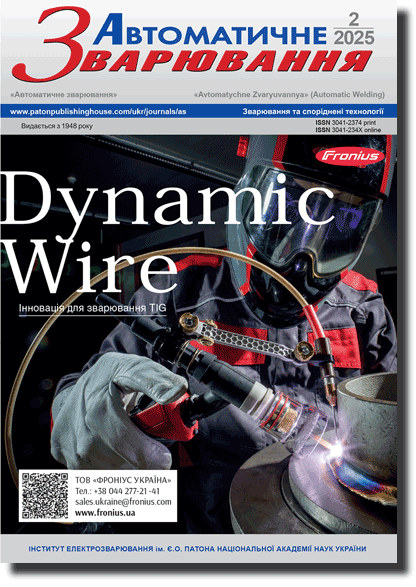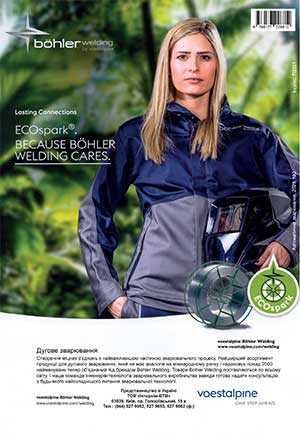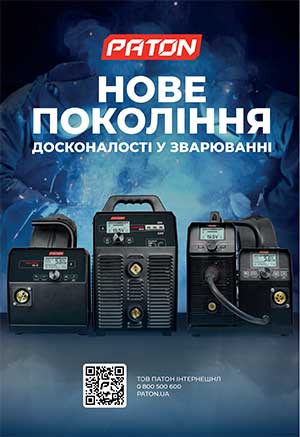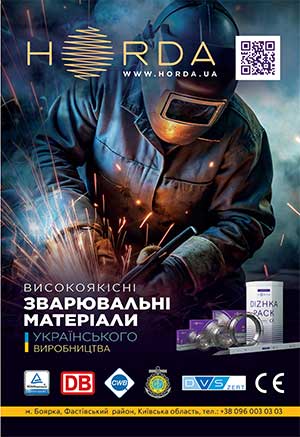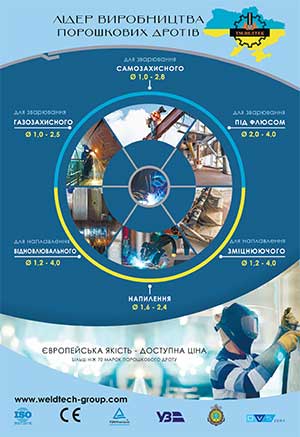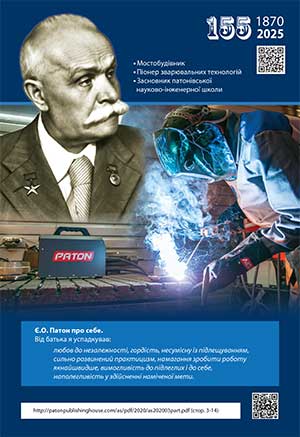| 2025 №02 (04) |
DOI of Article 10.37434/as2025.02.05 |
2025 №02 (06) |
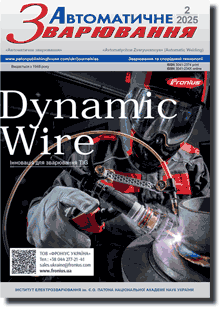
"Avtomatychne Zvaryuvannya" (Automatic Welding), #2, 2024, pp. 38-44
Methodology for evaluating the welding and technological properties of flux-cored wires for arc surfacing
A.A. Babinets, I.O. Ryabtsev, I.P. Lentyugov
E.O. Paton Electric Welding Institute of the NAS of Ukraine 11 Kazymyr Malevych Str., 03150, Kyiv, Ukraine. E-mail: E-mail: a_babinets@ukr.netAn analysis of existing methods for evaluating the welding and technological properties of electrode materials used in electric arc surfacing and welding has been conducted. The fundamental principles for assessing the stability of the arc process have been reviewed. The key approaches to studying the properties of electrode materials and the list of controlled parameters most frequently used for this purpose have been determined. It has been demonstrated that quantitative evaluation criteria are more advantageous compared to qualitative ones. Based on the analysis, a comprehensive methodology for evaluating the welding and technological properties of flux-cored wires has been developed, comprising three main components. The first component includes a visual expert assessment of the arc surfacing process and the quality of the deposited metal formation, performed using a differential scoring system. The second component focuses on evaluating the melting characteristics of flux-cored electrode wires based on experimentally determined melting rates, deposition rates, and material loss coefficients. The third component involves assessing the stability of the arc process, which is conducted using experimentally determined coefficients of variation for current and voltage fluctuations on the arc. The advantages of the proposed comprehensive methodology have been demonstrated through the evaluation of real flux-cored wires for arc surfacing. It has been established that this methodology provides more informative results compared to approaches relying solely on qualitative indicators. The study confirmed that the type and particle size distribution of metallic components in the core of flux-cored wires significantly influence the stability of the arc surfacing process. The use of chemically more pure and more homogeneous metallic granular powders in the flux-cored wire core, compared to ferroalloy powders, improves the stability and efficiency of the surfacing process by 15–30%. 19 Ref., 2 Tabl., 2 Fig.
Keywords: arc surfacing, flux-cored wire, deposited metal, welding and technological properties, surfacing stability, coefficients of variation
Received: 24.01.2025
Received in revised form: 26.02.2025
Accepted: 03.04.2025
References
1. Ryabtsev, I., Fomichov, S., Kuznetsov, V. et al. (2023) Surfacing and Additive Technologies in Welded Fabrication. Switzerland, Springer Nature AG. ISBN 978-3-031-34390-2. https://doi.org/10.1007/978-3-031-34390-22. Pokhodnya, I.K., Shlepakov, V.N., Maksimov, S.Yu., Ryabtsev, I.A. (2010) Research and developments of the E.O. Paton Electric Welding Institute in the field of electric arc welding and surfacing using flux-cored wire (Review). The Paton Welding J., 12, 26-33.
3. Pokhodnya, I.K., Suptel, A.M., Shlepakov, V.N. (1972) Welding with flux-cored wire. Kyiv, Naukova Dumka [in Russian].
4. Pokhodnya, I.K., Gorpenyuk, V.N., Milichenko, S.S. et al. (1990) Metallurgy of arc welding: Processes in the arc and melting of electrodes. Kyiv, Naukova Dumka [in Russian].
5. Golovko, V., Kotelchuk, O., Naumeiko, S., Golyakevich, for arc welding of low-alloy steels. Defect and Diffusion Forum, 416, 103-114. https://doi.org/10.4028/p-58v9g5
6. Shlepakov, V.N. (2014) Physical-metallurgical and welding-technological properties of gas-shielded flux-cored wires for welding of structural steels. The Paton Welding J., 6-7, 53-56. https://doi.org/10.15407/tpwj2014.06.10
7. Kostin, O.M., Yaros, O.O., Yaros, Y.O., Savenko, O.V. (2021) UPE-500 complex for determining welding and technological characteristics of coated electrodes. The Paton Welding J., 8, 33-37. https://doi.org/10.37434/tpwj2021.08.07
8. Pawlik, J., Bembenek, M., Goral, T. et al. (2023) On the influence of heat input on Ni-WC GMAW hardfaced coating properties. Materials, 16(11), 3960. https://doi.org/10.3390/ma16113960
9. Beczkowski, R., Gucwa, M. (2017) Cladding hardfacing layers used to protect the surface against abrasive wear. In: Proc. 26th International Conference on Metallurgy and Materials, Brno, Czech Republic, May 24-26, 1188-1193.
10. Kakhovs'kyi, M.Y. (2016) Influence of aqueous media on the gas saturation of weld metal in the course of underwater welding of 12KH18N10T steel. Materials Science, 51, 843-846. https://doi.org/10.1007/s11003-016-9911-7
11. Zhang, M., Wang, Y., Zhang, W.-H. et al. (2018) Development of gas shielded flux cored wire for 1Cr12Ni2W1MoV stainless steel and properties of welded joint. Transactions of Materials and Heat Treatment, 39(11), 129-136. DOI: https://doi.org/10.13289/j.issn.1009-6264.2018-0215
12. Lankin, Yu.N. (2011) Indicators of stability of the GMAW process. The Paton Welding J., 1, 6-13.
13. Shlepakov, V.N., Kotelchuk, A.S., Gavrilyuk, Yu.A. (2017) Modern flux-cored wires for welding of low-alloy steels of increased and high strength. The Paton Welding J., 11, 8-12. https://doi.org/10.15407/tpwj2017.11.01
14. Majdanchuk, T.B., Skorina, N.V. (2014) Improvement of adaptability to fabrication and welding properties of electrodes for tin bronze welding and surfacing. The Paton Welding J., 6-7, 172-176. https://doi.org/10.15407/tpwj2014.06.37
15. Zhudra, A.P., Krivchikov, S.Yu., Dzykovich, V.I. (2014) Application of complex-alloyed powders produced by thermocentrifugal sputtering in flux-cored wires. The Paton Welding J., 12, 36-40. https://doi.org/10.15407/tpwj2014.12.08
16. Voronchuk, A.P., Zhudra, A.P., Petrov, A.V., Kochura, V.O. (2019) Influence of modes of flux-cored strip surfacing on their welding-technological properties. The Paton Welding J., 1, 33-37. https://doi.org/10.15407/tpwj2019.01.07
17. Ryabtsev, I.O., Babinets, A.A., Lentyugov, I.P. (2023) Welding-technological properties of flux-cored wire with boron-containing binder in the charge. The Paton Welding J., 9, 17-20. https://doi.org/10.37434/tpwj2023.09.03
18. Ryabtsev, I.O., Babinets, A.A., Lentyugov, I.P. et al. (2024) Welding and technological properties of flux-cored wire with the charge in the form of granulated powder. The Paton Welding J., 7, 17-21. https://doi.org/10.37434/tpwj2024.07.03
19. Mackenzie, J.G., Allen, M. (1998) Mathematical power tools: Maple, Mathematica, Matlab and Excel. Chemical Engineering Education, 32(2), 156-160.
Advertising in this issue:
To order the electronic version of the paper:
A.A. Babinets, I.O. Ryabtsev, I.P. LentyugovMethodology for evaluating the welding and technological properties of flux-cored wires for arc surfacing
Automatic Welding №02 2025 p.38-44
The cost of article (pdf): 13 $, 12 €, 150 UAH (1 copy. )
fill in the form below:
The cost of subscription/purchase order journals or individual articles
| Journal/Currency | Annual Set | 1 issue printed |
1 issue |
one article |
| TPWJ/USD | 384 $ | 32 $ | 26 $ | 13 $ |
| TPWJ/EUR | 348 € | 29 € | 24 € | 12 € |
| TPWJ/UAH | 7200 UAH | 600 UAH | 600 UAH | 280 UAH |
| AS/UAH | 1800 UAH | 300 UAH | 300 UAH | 150 UAH |
| AS/USD | 192 $ | 32 $ | 26 $ | 13 $ |
| AS/EUR | 180 € | 30 € | 25 € | 12 € |
| SEM/UAH | 1200 UAH | 300 UAH | 300 UAH | 150 UAH |
| SEM/USD | 128 $ | 32 $ | 26 $ | 13 $ |
| SEM/EUR | 120 € | 30 € | 25 € | 12 € |
| TDNK/UAH | 1200 UAH | 300 UAH | 300 UAH | 150 UAH |
| TDNK/USD | 128 $ | 32 $ | 26 $ | 13 $ |
| TDNK/EUR | 120 € | 30 € | 25 € | 15 € |
AS = «Automatic Welding» - 6 issues per year;
TPWJ = «PATON WELDING JOURNAL» - 12 issues per year;
SEM = «Electrometallurgy Today» - 4 issues per year;
TDNK = «Technical Diagnostics and Non-Destructive Testing» - 4 issues per year.





